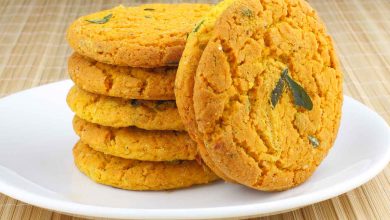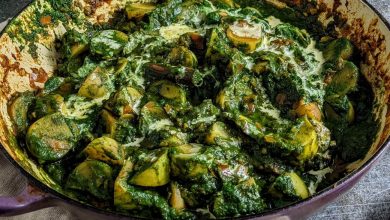Homemade Dijon Mustard Sauce Recipe: A Flavorful Classic Condiment
Dijon mustard is a versatile and zesty condiment that elevates the flavor of various dishes, from sandwiches to sauces, marinades, and dressings. This Homemade Dijon Mustard Sauce recipe is an easy, yet flavorful, version of the popular mustard, with ingredients that you likely already have in your kitchen. It’s the perfect addition to any meal and brings a rich, tangy, and slightly spicy kick that can transform the simplest of dishes.
Ingredients for Homemade Dijon Mustard Sauce
| Ingredients | Quantity |
|---|---|
| Mustard seeds (Rai/Kadugu) | 1/4 cup |
| Yellow mustard seeds | 1/4 cup |
| Dry white wine (Sauvignon Blanc or Chardonnay) | 1/2 cup |
| White Wine vinegar | 1/4 cup |
| Honey | 1 tablespoon |
| Salt | 1 teaspoon |
Preparation & Cooking Time
| Preparation Time | Cooking Time |
|---|---|
| 0 minutes (Marination Time) | 20 minutes (Grinding & Final Preparation) |
Instructions for Homemade Dijon Mustard Sauce
-
Marinate the Mustard Seeds:
The key to creating a flavorful Dijon mustard starts with marinating the mustard seeds. Begin by adding both the mustard seeds (Rai and yellow mustard) into a non-reactive container—glass or ceramic is ideal, as metal containers can impart a bitter taste to the mustard. Combine the mustard seeds with dry white wine and white wine vinegar in the container. Seal it tightly and let it marinate at room temperature for at least 2 days.Related Articles -
Grind the Mustard Seeds:
After marination, the mustard seeds should have absorbed the flavors of the wine and vinegar, making them soft and ready to blend. You can either use a high-speed blender or a traditional stone mortar and pestle to grind the mustard seeds along with the wine and vinegar mixture. Aim for a coarsely smooth consistency that will give your Dijon mustard its characteristic texture. If using a blender, pulse in short bursts to control the texture. -
Add Sweetness and Seasoning:
Once the mustard seeds are ground to your desired consistency, stir in honey and salt. The honey adds a subtle sweetness that balances the tangy vinegar and wine, while the salt brings out the flavors and enhances the mustard’s savory depth. -
Rest the Mustard:
Let the ground mustard rest for another 24 hours at room temperature. This will allow the flavors to meld and develop further, resulting in a richer, more complex taste. -
Storage and Shelf Life:
After 24 hours, your Dijon mustard is ready to use. Transfer it to a clean, airtight glass jar or container with a tight-fitting lid. The mustard can be stored in the refrigerator for up to 3 months, allowing you to enjoy this homemade condiment for weeks to come.
Tips for Success
- Non-Reactive Containers: Always use glass, ceramic, or stoneware containers to marinate mustard seeds. Avoid metal containers, as the acid in the vinegar and wine can react with the metal and affect the taste of your mustard.
- Wine Selection: The choice of dry white wine can significantly affect the flavor. A crisp wine like Sauvignon Blanc or Chardonnay is ideal as it complements the mustard’s tanginess.
- Customization: Feel free to experiment with the amount of honey and salt depending on how sweet or salty you prefer your Dijon mustard. For a spicier version, you can add a pinch of cayenne pepper or garlic powder.
Serving Suggestions for Your Homemade Dijon Mustard Sauce
- Classic Sandwich Spread: Spread a generous amount of your homemade Dijon mustard on your sandwiches, burgers, or wraps for that signature zesty bite.
- Salad Dressings and Vinaigrettes: Use Dijon mustard as a base for homemade vinaigrettes. Combine with olive oil, honey, and lemon juice for a tangy dressing.
- Marinades and Glazes: The mustard sauce also works wonderfully in marinades for chicken, beef, or pork, and can be used to glaze meats during roasting or grilling.
- Condiment Pairings: Serve alongside your favorite charcuterie board or with pretzels for a delicious and tangy dip.
Nutritional Information (Per Serving)
| Nutrient | Amount |
|---|---|
| Calories | ~15 kcal per 1 tablespoon serving |
| Total Fat | 0g |
| Sodium | 120 mg |
| Carbohydrates | 3g |
| Sugar | 2g |
| Protein | 1g |
Conclusion
Making Dijon mustard at home is a simple yet satisfying process. By marinating the mustard seeds in white wine and vinegar, you bring out the mustard’s rich flavors, which can then be enhanced with honey and salt. This homemade Dijon Mustard Sauce is a must-have for any pantry and can be used in various dishes, making it a staple condiment that will elevate your cooking. Once you try this recipe, you’ll never want to go back to store-bought mustard again!




